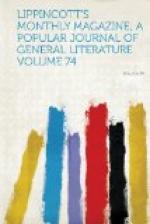But besides the unfavorable nature of the climate and soil of Munich—which cannot be helped—and the shameful condition of its sewerage and water-supply—for which the city government is mainly responsible—there are many accessory causes of disease to be found in the habits and customs of the people. The open-air gatherings of the Germans are, in many respects, a pleasant-and praiseworthy trait of their social life, but the practice needs to be held in judicious restraint to make it safe for the citizens of Munich. The changes of temperature in that region are so frequent and so severe, and the atmosphere at night is so heavily charged with moisture and malaria, that the mere tarrying late in public gardens is dangerous; but when to this source of danger are added the imbibing of copious draughts of ice-cold beer and the eating of suppers of heavy food, such as sausages, roast pork, radishes, etc., it is easy to see how a sudden check of perspiration might react upon a gorged stomach and produce the fevers and inflammation which abound.
Attention has been called to the peculiar soil of Munich as a disadvantageous characteristic of the locality. There is, however, a strip of land following the course of the Isar and bordering the city on the north-eastern side, which is an exception to the general barrenness, it having been gradually formed out of the soil and vegetation brought down the river from more fruitful regions during periods of inundation. It is a low, marshy, heavily-timbered tract, which has been partially drained and laid out as a public park, the so-called English Garden—spot beloved of the people for its welcome shades, where artificial waterfalls, from the “Isar rolling rapidly,” add chill to the natural dampness; where unwilling streamlets creep slowly through tortuous channels toward a stagnant pond, and pestiferous miasma, rising like incense at the going down of the sun, broods over the meadows until his rising again. It was in one of the streets bordering this park that the cholera broke out in 1873, and there too, Kaulbach, one of its last victims, had his home. So notorious is the spot as a breeding-place of typhus that it is generally abandoned at sunset; but the same crowd that hurry out of its dripping shades at twilight return in the early summer mornings before the dew has dried on the grass or the poisonous damps have exhaled from the glens and thickets.




